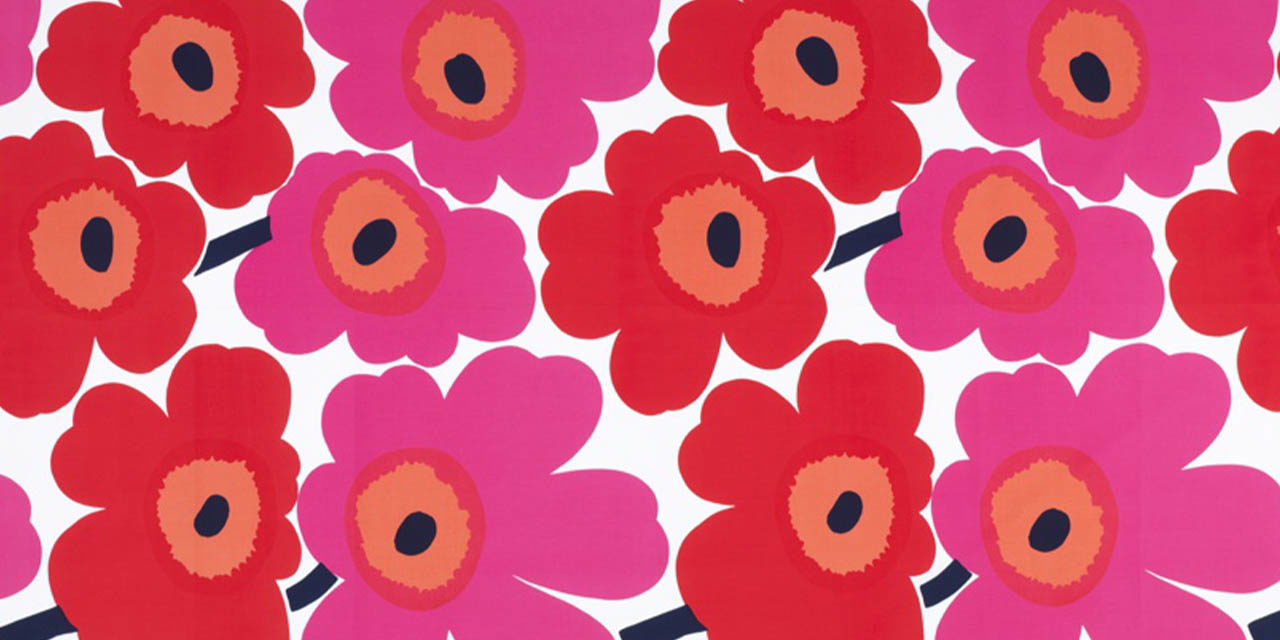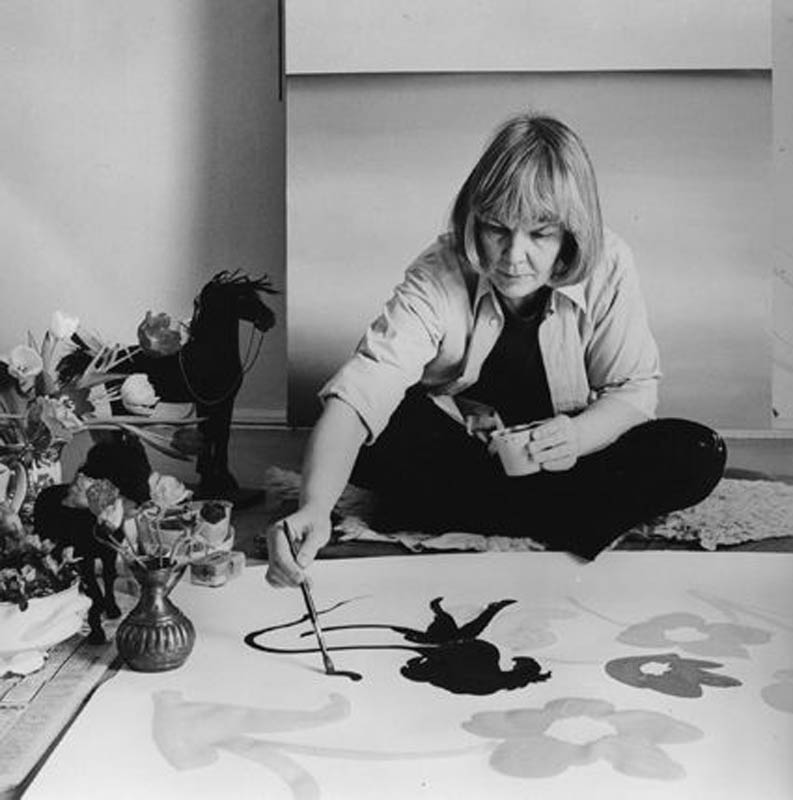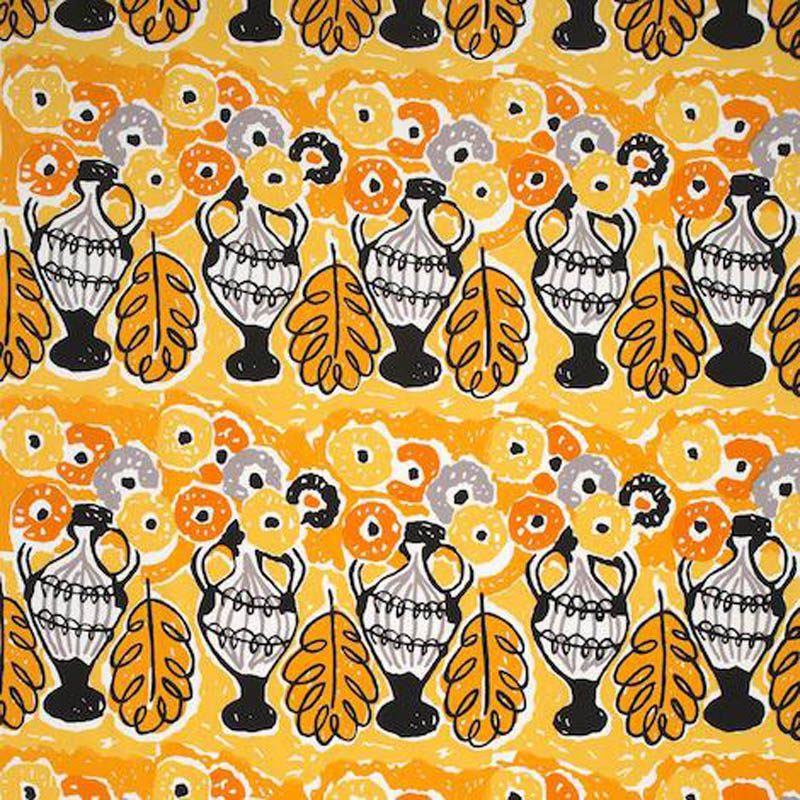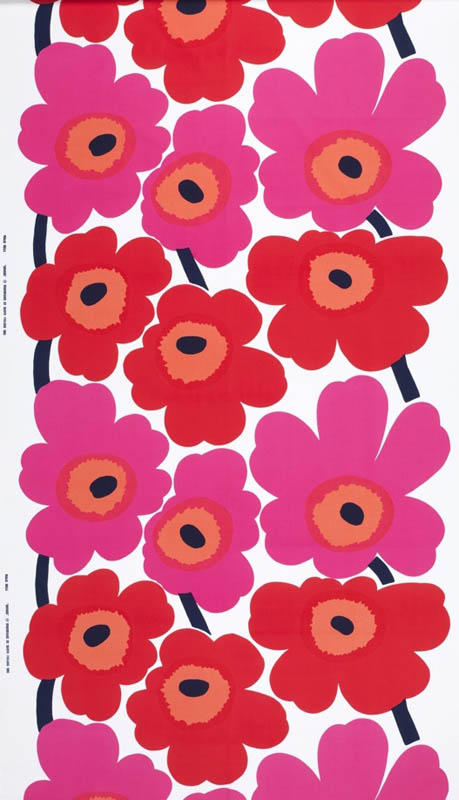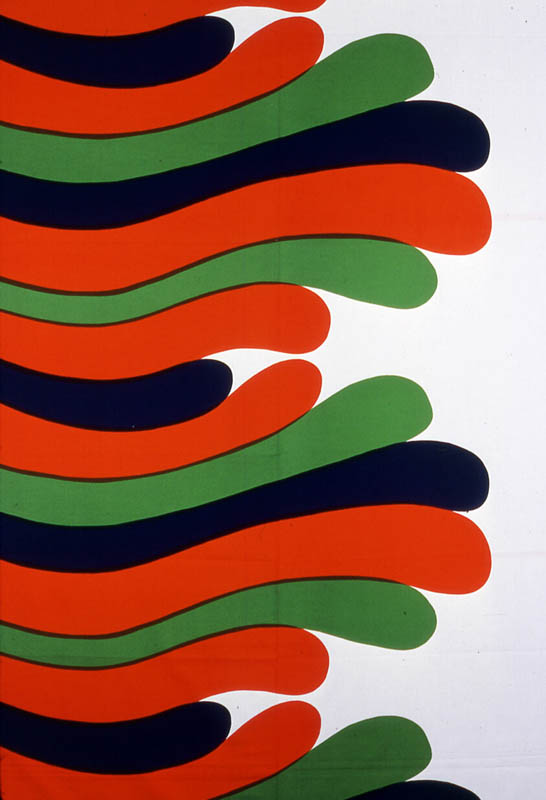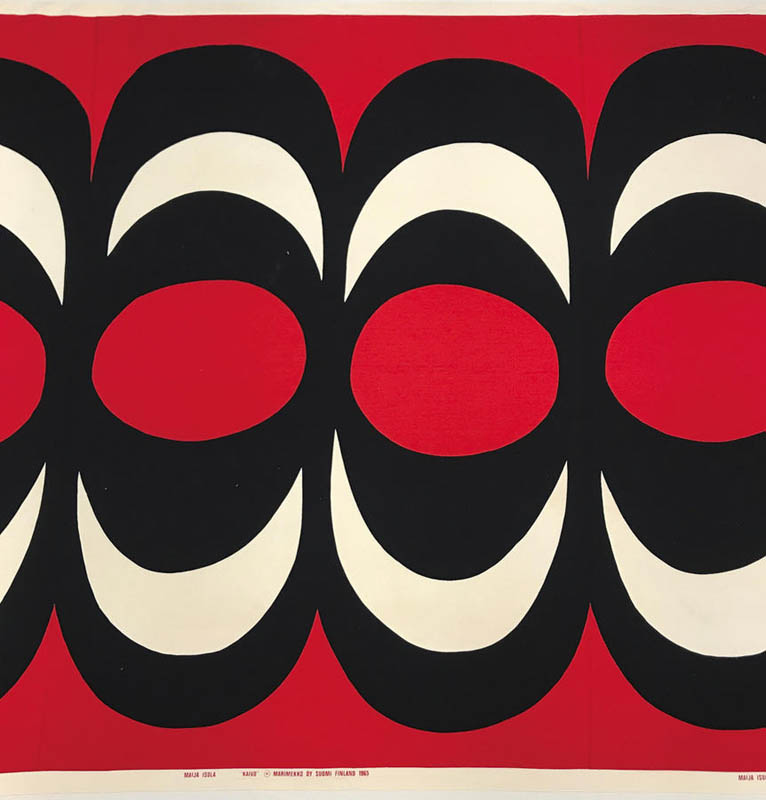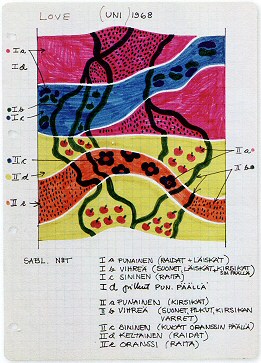About the Designer
Whenever Jackie Kennedy appeared alongside John F. Kennedy during his presidential campaign in 1960 the world would stop and stare. When she was featured on the cover of Sports Illustrated wearing a dress from the Finnish design house, Marimekko, the brand became a key player in 60s fashion (Fig. 1 / Marimekko). The designer behind the dress’ bright colors and print was Maija Isola (Fig. 2), who famously abandoned conservative floral designs in favor of bold, graphic styles. Isola’s work was intended to break away from traditional cycles of fashion, instead, pointing towards a more enduring look (Pritchard).
Mostly associated with Marimekko, Maija Isola became a household name when Ben Thompson, founder of Design Research, encountered her work at the World Fair in Brussels in 1958 (Aav). Nothing like it had been seen in America, and it became an instant international sensation.
With unique floral and nature-inspired designs, her work is exhibited in museums including the Victoria and Albert Museum, Design Museum Copenhagen, and the Minneapolis Institute of Arts (Karjalainen).
Born in Riihimäki Finland, Isola was the youngest of 3 daughters. Her father, Mauno Isola, was a farmer who was also known for writing a famous Finnish Christmas carol (Karjalainen).
Her life dramatically changed as the Second World War ended. Her father passed away, she entered into her first marriage, and gave birth to her daughter, Kristina, in 1945 (Wilhilde / Design Week). After getting her bearings, she would be inspired by an Oslo trip in 1948, visiting a Van Gogh exhibition (Wilhide). She came across several of Edvard Munch’s paintings which inspired her first famous print, Amphora (see gallery).
She later studied at the Central School of Industrial Arts in Helsinki. Graduating in 1949, she joined a newly founded textile company called Printex. Through a Printex partnership with Marimekko, she would work closely with the firm and eventually would become the principal designer of Marimekko (Karjalainen).
Isola was a free spirit and traveled widely around the world, absorbing cultural influences that enriched her work. Like many Scandinavian designers, she had an affinity for nature and folk art. She would employ the photogram process, using real plants to create her patterns (Wilhide).
Between 1957-1963, she created her first series of works on a single theme, Nature (see gallery). It contained 30 designs based on plants pressed by her daughter, Kristina. Another series, Ornament based on Slavic art, also contained 30 designs displaying a strong graphic style; crisp outlines, flat patterning, and over-scale repeats. She would develop a bold sense of color while also being in tune with the dynamic spirit of Pop art (Jackson).
While at Marimekko, founder Armi Ratia and Isola had an interesting relationship. Some described it as “unusual creative power with vitality and inventiveness rather than harmonious understanding” (Aav).
Before Poppy (see gallery) was created in 1965, there was a common misconception that Isola would never design floral prints. That’s because Ratia would often claim that Isola severely disliked them. She would later defy this statement, pushing her to create her most famous pattern.
Fig. 1 - Photographer unknown. Sports Illustrated Cover, December 26, 1960. Source: Sports Illustrated Vault Archives
Fig. 2 - Photographer unknown. Maija Isola. Source: Design Museet
The asymmetric design, clash of colors, and use of graphical contrast made Poppy an instant success. It embodied the design confidence of the 60s and is still one of the most popular prints for the home market today (Aav).
From 1965-1967 she began working within the theme of sun and sea. Creating designs like Albatross (see gallery), Jellyfish, and Oyster. Her rise in the early 60s made these designs extremely popular. In 1965, she designed Well (see gallery), which is still being produced by Marimekko today (Marimekko).
Then in 1970, a love affair with Egyptian scholar Ahmed Al-Haggagi would cause a style shift. Al-Haggagi encouraged her to work within Arab patterns. Because of this influence, she created wonderful new work. It included famous prints like Mask, Storytellers, and Dark (Aav).
Towards the end of her career, between 1980-1987, she worked closest with her daughter, Kristina, who at the time became a lead designer at Marimekko. Kristina opened the door to unique colorways based on her mother’s prints and many remain in production today (Design Week).
Today, at Marimekko, Isola’s pattern books remain a staple in their design process (see gallery). Her handwritten exercise books contain precise detail of her pattern repeats and are used as a production guide for their products (Wilhide).
Over her 40 year career, Isola created 533 prints (Minneapolis Institute of Art). Her prints have seen a recent revival with a renewed and fresh interest in decorative design. She later retired from the textile industry and design to focus on painting–a fitting ending to an illustrious career (Ekman).
GALLERY
Maija Isola (Finnish, 1927-2001). Amphora (Amfora), 1949. Source: Scandinavia Design
Maija Isola (Finnish, 1927-2001). Nature (Luonto), 1957. Source: Design Museet
Maija Isola (Finnish, 1927-2001). Poppy (Unikko), 1965. Cotton; 202.3 x 137.2 cm. New York: Cooper Hewitt, 1979-89-7. Gift of Marimekko, Inc. Source: Cooper Hewitt
Maija Isola (Finnish, 1927-2001). Albatross (Albatrossi), 1967. Cotton, plain weave; screen printed; 366.1 x 139.5 cm. Chicago: Art Institute of Chicago, 1980.138. Gift of Marimekko, Inc. Source: Art Institute of Chicago
Maija Isola (Finnish, 1927-2001). Well (Kaivo), 1965. Cotton, plain weave; screen printed; width: 133.4 cm. Providence: RISD Museum, 2018.120.7. Gift of Mark C. K. Lu in memory of his father Paul C. K. Lu. Source: RISD Museum
Maija Isola (Finnish, 1927-2001). Page from Maija Isola's "Pattern Books", showing her construction of her 1968 textile pattern Lovelovelove, 1968. Source: Wikipedia
To Learn more:
- Aav, Marianne. Marimekko: Fabrics, Fashion, Architecture (Bard Graduate Centre For Studies In The Decorative Arts, Design & Culture). Yale University Press, 2010. http://www.worldcat.org/oclc/819135876
- Ekman, Ivar. “Nostalgia for a Modern Finnish Designer.” The New York Times, August 23, 2005, sec. Fashion. https://www.nytimes.com/2005/08/23/style/nostalgia-for-a-modern-finnish-designer.html.
- Jackson, Lesley. Twentieth-Century Pattern Design. Princeton Architectural Press, 2007, p. 128. http://www.worldcat.org/oclc/915295507.
- Karjalainen, Tuula. “Isola, Maija.” National Biography of Finland, https://kansallisbiografia.fi/english/person/8543.
- Marimekko. “History – Marimekko as a Company,” n.d. https://company.marimekko.com/en/about-marimekko/history/.
- Minneapolis Institute of Art. “Silkkikuikka, Maija Isola,” n.d. http://collections.artsmia.org/art/8315/silkkikuikka-maija-isola.
- Pritchard, Dean. “MARIMEKKO #x2026; A WAY OF LIFE.” Women’s Wear Daily, vol. 114, no. 33, Feb 16, 1967, pp. 16-17. ProQuest, https://libproxy.fitsuny.edu:2365/magazines/marimekko-x2026-way-life/docview/1565340290/se-2?accountid=27253.
- “Profile: Kristina Isola.” Design Week, 2005, p. 13. Gale General OneFile, https://link.gale.com/apps/doc/A136054620/ITOF?u=fitsuny&sid=bookmark-ITOF&xid=573754c4.
- Watson-Smyth, Kate. “The Secret History Of: Marimekko Unikko Fabric” The Independent, 22 Oct. 2011, https://www.independent.co.uk/property/interiors/secret-history-marimekko-unikko-fabric-2184168.html.
- Wilhide, Elizabeth. The Complete Pattern Directory: 1500 Designs from All Ages and Cultures. Running Press Book Publishers, 2018, p. 66. http://www.worldcat.org/oclc/1059410951

